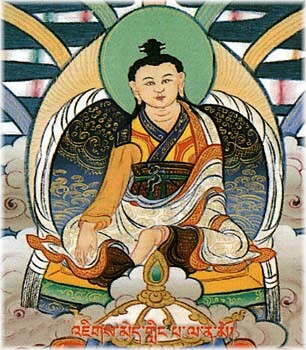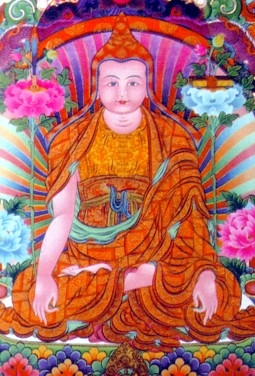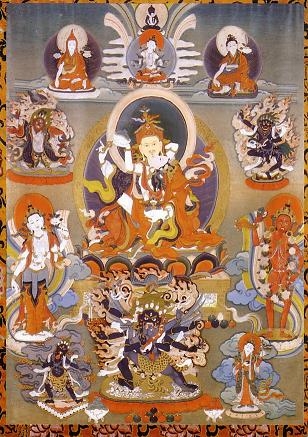Longchen Nyingtik: Difference between revisions
m (addition of lineage holder to present-day masters) |
(this list is only of present day living teachers) |
||
| Line 143: | Line 143: | ||
:*[[Trulshik Rinpoche]] | :*[[Trulshik Rinpoche]] | ||
:*[[Dodrupchen Rinpoche|Dodrupchen IV]] | :*[[Dodrupchen Rinpoche|Dodrupchen IV]] | ||
:*[[Sogyal Rinpoche]] | :*[[Sogyal Rinpoche]] | ||
:*[[Khangsar Tenpé Wangchuk]] | :*[[Khangsar Tenpé Wangchuk]] | ||
| Line 153: | Line 152: | ||
:*[[Shechen Rabjam Rinpoche]] | :*[[Shechen Rabjam Rinpoche]] | ||
:*[[Khenpo Chöga]] | :*[[Khenpo Chöga]] | ||
==Notes== | ==Notes== | ||
Revision as of 10:00, 22 December 2009

Longchen Nyingtik (Wyl. klong chen snying thig) — a Nyingma cycle of teachings and practice, which was discovered by Jikmé Lingpa as mind terma.
The Revelation of Longchen Nyingtik
Regarding the revelation of the Longchen Nyingtik teachings, Tulku Thondup writes:
- While Guru Rinpoche was visiting Tibet…he conferred the Longchen Nyingtik teachings on King Trisong Detsen, Khandro Yeshe Tsogyal, and Vairochana… He gave prophetic empowerments by saying that the teachings would be discovered by Jikmé Lingpa, an incarnation (tulku) of King Trisong Detsen.
- So centuries later, when the prophetic empowerments of Guru Rinpoche ripened and the favorable circumstances came to fruition, the concealed Longchen Nyingtik teachings were accordingly awakened in the enlightened mind of Jikmé Lingpa as mind ter.[1]
Jikmé Lingpa discovered the Longchen Nyingtik teachings as mind ter at the age of twenty-eight. Tulku Thondup writes:
- In the evening of the twenty-fifth day of the tenth month of the Fire Ox year of the thirteenth Rabjung cycle (1757), Jikmé Lingpa went to bed with an unbearable devotion to Guru Rinpoche in his heart; a stream of tears of sadness continuously wet his face because he was not in Guru Rinpoche’s presence, and unceasing words of prayers kept singing in his breath.
- He remained in the depths of that meditation experience of clear luminosity for a long time. While being absorbed in that luminous clarity, he experienced flying a long distance through the sky while riding a white lion. He finally reached a circular path, which he thought to be the circumambulation path of Jarung Khashor, now known as Boudhanath Stupa, an important Buddhist monument of giant structure in Nepal. [2]
In this vision, the wisdom dakinis gave Jikmé Lingpa a casket containing five yellow scrolls and seven crystal beads. One of the scrolls contained the prophetic guide of Longchen Nyingtik, called Nechang Thukkyi Drombu. At the instruction of a dakini, he ate the yellow scrolls and crystal beads, and all the words and meaning of the Longchen Nyingtik terma were awakened in his mind.
Jikmé Lingpa kept this terma secret for years, and he did not even transcribe the terma until he entered another retreat in which he had a series of visions of Longchen Rabjam. Tulku Thondup explains:
- In the earth-hare year (1759) he started another three-year retreat, at Chimpu near Samye monastery. During that retreat, because he was inspired by three successive pure visions of Longchen Rabjam, and he was urged by repeated requests of dakinis, he transcribed his terma as the cycle of Longchen Nyingtik. On the tenth day of the sixth month (monkey month) of the monkey year (1764) he made his terma public for the first time by conferring the transmission of empowerment and the instructions upon fifteen disciples. [3]
The Longchen Nyingtik terma consists of tantric sadhanas and teachings.
The Nyingtik Teachings
The Nyingtik teachings are the innermost secret teachings of Dzogchen. The Dzogchen teachings were revealed to Prahevajra (Tib. Garab Dorje) by Vajrasattva, and passed down through an unbroken lineage to present day masters. Within the Dzogchen teachings, there are three categories of teachings suitable to students of different capacity. The Nyingtik is the innermost secret cycle of teachings of the Category of Pith Instructions; this cycle is the most direct approach for students of the highest capacity.
Within the Nyingtik teachings, there are tantras and instructional texts. Regarding the instructional texts, Tulku Thondup explains:
- The instructional teachings are elucidated and condensed in two major traditions of Nyingtik. The first one is the detailed teachings for/of the scholars, brought to Tibet by Vimalamitra and known as Vima Nyingtik. It is mainly based on the Seventeen Tantras and the Troma tantra. The second one is the profound teachings for/of mendicants [or yogis], brought to Tibet by Guru Padmasambhava and known as Khandro Nyingtik. It is mainly based on the Longsal Barma tantra. [4]
In the fourteenth century in Tibet, the great master Longchen Rabjam became the lineage holder of both of these Nyingtik traditions, and wrote a commentary on each tradition.
Longchen Rabjam, Jikmé Lingpa, and the Longchen Nyingtik Lineage

Longchen Rabjam (1308-1364), also known as Longchenpa, was one of the greatest Dzogchen masters in the Nyingma tradition, and amongst the most brilliant and original writers in Tibetan Buddhist literature. He brought together into a cohesive system the teachings of Vima Nyingtik and Khandro Nyingtik, on which he wrote the ‘Three Yangtik’ or Inner Essencess.
Four centuries later, Jikmé Lingpa was tremendously inspired by the teachings of Longchenpa. After Jikmé Lingpa discovered the terma of Longchen Nyingtik (which included tantric sadhanas and teachings) he entered into a three-year retreat in the caves of Chimphu in which he fervently invoked Longchenpa with a Guru Yoga he had composed. Longchenpa appeared to him in three visions, through which he received the blessing and transmission of the wisdom body, speech and mind of Longchenpa, empowering him with the responsibility of preserving the meaning of the teachings of Longchenpa, and of spreading them. As a result, Jikmé Lingpa’s mind became one with the wisdom mind of Longchenpa.
In this way, Jikmé Lingpa became the lineage holder of Longchenpa’s teachings on the Vima Nyingtik and Khandro Nyingtik. Jikmé Lingpa was a reincarnation of both King Trisong Detsen and Vimilamitra. Therefore, the Nyingtik teachings of these two major lineages flowed together in Jikmé Lingpa.
The Longchen Nyingtik lineage includes both the terma of Longchen Nyingtik discovered by Jikmé Lingpa, and teachings of Longchen Rabjam on Vima Nyingtik and Khandro Nyingtik that were revealed to Jikmé Lingpa in a series of visions.
The Stages of Practice
Dilgo Khyentse Rinpoche said:
- The cycle of the Longchen Nyingtik is composed of many sections. It includes the preliminary and main practices, the development and completion stages, and, most important, the practice of Ati Yoga, or Dzogchen. It thus constitutes a complete path to enlightenment.[5]
In the Longchen Nyingtik tradition, the preliminary (or ngöndro) practices are commonly referred to as the Longchen Nyingtik Ngöndro.
After completing the ngondro, training in the development and completion stages is done through sadhana practices such as Rigdzin Dupa. Traditionally, a student trains in a series of three sadhanas known as the Three Roots.
Finally, if the student is sufficiently prepared, a qualified teacher may give the students instructions in Dzogchen, which focus on the direct realization of the nature of mind.
The Major Texts

The major texts of Longchen Nyingtik are as follows:
Original Tantras
- The root tantra: Kuntu Zangpo Yeshe Longki Gyü
- The subsequent tantra: Gyü Chima
- Teachings: Kuntu Zangpö Gong-nyam
- Instructions
- a. Instructions: Nesum Shenje and Neluk Dorje Tsigang
- b. Their commentaries: Yeshe Lama with its supporting texts
- a. Instructions: Nesum Shenje and Neluk Dorje Tsigang
Sadhanas
1. Male vidyadharas
- a. Peaceful:
- outer: Guru Yoga
- inner: Rigdzin Düpa
- secret: Dukngal Rangdrol
- innermost secret: Ladrup Tiklé Gyachen
- outer: Guru Yoga
- b. Wrathful:
- blue: Palchen Düpa
- red: Takhyung Barwa
- blue: Palchen Düpa
2. Female vidyadharas
- a. Peaceful: root sadhana: Yumka Dechen Gyalmo
- b. Wrathful: secret sadhana: Senge Dongchen
The Detailed Longchen Nyingtik Lineage
Some of the main lineage holders of the Longchen Nyingtik lineage are listed below.
First stage
- Samantabhadra, the Dharmakaya
- Vajrasattva, the Sambhogakaya
- Prahevajra (Tib. Garab Dorje), the Nirmanakaya; the first human master of Dzogpa Chenpo
- King Trisong Detsen, received Nyingtik teachings from Guru Rinpoche and Vimalimitra
- Yeshe Tsogyal
- Vairotsana
- Longchen Rabjam
- Ridgzin Jigmé Lingpa, revealed the Longchen Nyingtik teachings
Later stages
- Dodrupchen I Jikmé Trinlé Özer, the direct disciple of Jigme Lingpa, he arranged and expanded on Jigme Lingpa’s revelation
- Jikmé Gyalwé Nyugu
- Dola Jikmé Kalzang
- Fourth Dzogchen Mingyur Namkhé Dorje
- Do Khyentse Yeshe Dorje
- Gyalsé Shenpen Tayé
- Dzogchen Khenpo Pema Dorje
- Patrul Jigme Chokyi Wangpo
Present day teachers
There are many present-day masters of the Longchen Nyingtik lineage; the list below includes some of the teachers most familiar to Rigpa students.
Notes
- ↑ Masters of Meditation and Miracles, by Tulku Thondup, pages 43-44.
- ↑ Masters of Meditation and Miracles, by Tulku Thondup, pages 122-123.
- ↑ Hidden Teachings of Tibet, An Explanation of the Terma Tradition of Tibetan Buddhism, by Tulku Thondup, pages 122-123.
- ↑ Masters of Meditation and Miracles, by Tulku Thondup, page 33.
- ↑ The Wish-Fulfilling Jewel: The Practice of Guru Yoga According to the Longchen Nyingtik Tradition, by Dilgo Khyentse, Shambhala Publications, page 8.
Further Reading
- Dilgo Khyentse Rinpoche, The Wish-Fulfilling Jewel: The Practice of Guru Yoga According to the Longchen Nyingtik Tradition, Shambhala Publications
- Patrul Rinpoche, The Words of My Perfect Teacher, translated by the Padmakara Translation Group, Shambhala 1994, revised ed. 1998
- Sam van Schaik, Approaching the Great Perfection: Simultaneous and Gradual Methods of Dzogchen Practice in the Longchen Nyingtig, Boston: Wisdom Publications, 2003
- Steven D. Goodman, 'Rig-'dzin Jigs-med gling-pa and the kLong-Chen sNying-Thig' in Tibetan Buddhism: Reason and Revelation edited by Steven D Goodman and Ronald M. Davidson, SUNY, 1992
- Tulku Thondup, Enlightened Journey, Boston & London, Shambhala, 1995
- Tulku Thondup, Masters of Meditation and Miracles, Shambhala, 1996